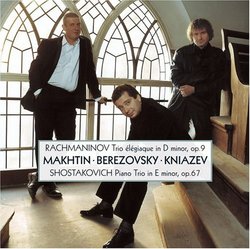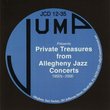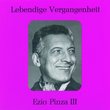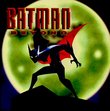| All Artists: Sergey Rachmaninov, Dmitry Shostakovich, Boris Berezovsky Title: Rachmaninov: Trio élégiaque, Op. 9; Shostakovich: Piano Trio, Op. 67 Members Wishing: 0 Total Copies: 0 Label: Warner Classics Release Date: 2/15/2005 Genre: Classical Styles: Chamber Music, Historical Periods, Classical (c.1770-1830) Number of Discs: 1 SwapaCD Credits: 1 UPC: 825646193721 |
Search - Sergey Rachmaninov, Dmitry Shostakovich, Boris Berezovsky :: Rachmaninov: Trio élégiaque, Op. 9; Shostakovich: Piano Trio, Op. 67
 | Sergey Rachmaninov, Dmitry Shostakovich, Boris Berezovsky Rachmaninov: Trio élégiaque, Op. 9; Shostakovich: Piano Trio, Op. 67 Genre: Classical
|
Larger Image |
CD DetailsSimilar CDs |
CD ReviewsFabulous playing D. A Wend | Buffalo Grove, IL USA | 04/15/2005 (5 out of 5 stars) "The Rachmaninov trio was composed in the wake of the death of Tchaikovsky, whom he had seen alive a few days before the sudden and tragic event. Rachmaninov had been a supporter of the older composer and the result of his shock over Tchaikovsky's death was to compose the trio elegiaque. Work on the trio was completed in two months and the premiere took place with Rachmaninov playing the piano part.
Rachmaninov modeled his trio on Tchaikovsky's. The grief that the composer felt is immediately evident in the quiet beginning. The piano plays first and is joined by the violin and cello, the music slowly rising to a crescendo and continuing in a passionate outburst. The music somewhat reminded me of the First Piano Suite but the anger expressed in this music is much more powerful. I got caught up in the development of the music as it alternated between sadness and anger, despite what seemed to be a huge movement of almost 20 minutes. The movement ends as quietly as it began. The second movement mirrors Tchaikovsky's trio with a theme and variations, here to the main melody of The Rock. The movement begins in a reflective tone and the piano part dominates the movement. One of the more memorable variations has the strings playing pizzicato to the piano's brilliant melody and much of the music is some of the most romantically atmospheric that Rachmaninov wrote. Far from being always sad and melancholy, the music of this movement explores the original theme with variety of tempi and great brilliance. The finale, also like the Tchaikovsky, is very short compared to the music that has come. The movement is agitated and turbulent in mood and becomes quiet, gradually, ending in darkness. The Shostakovich trio was also composed as a memorial - the death of his friend Ivan Sollertinsky. The trio dates from the War years, between the 8th and 9th symphonies. The opening has the cello playing softly, almost eerie, high notes that sets the tone of sadness. The violin joins in playing low notes followed by the piano, playing an octave below the violin. Slowly, the movement takes shape and the tempo quickens with nice interactions between the players. The second movement is playfully boisterous, suggesting a humorous side of Sollertinsky. The Largo, as might be expected, is a gloomy movement returning to the feel of the opening movement. The final movement begins with the violin playing pizzicato, joined by the piano and cello in a nicely rhythmical theme typical of Shostakovich. The theme develops slowly recalling the theme of the first movement and a theme that is Hebraic in sound. Then the music shifts to an Adagio that brings back the chords of the third movement and ends quietly. My interest in this CD can from a glowing review I read, which is fully justified. I have a good selection of chamber music but it is by no means high in my collection. This CD will remain one of my favorites for the excellent performances and the outstanding playing by Dmitri Makhtin, Boris Berezovsky and Alexander Kniaze. " |

 Track Listings (7) - Disc #1
Track Listings (7) - Disc #1


